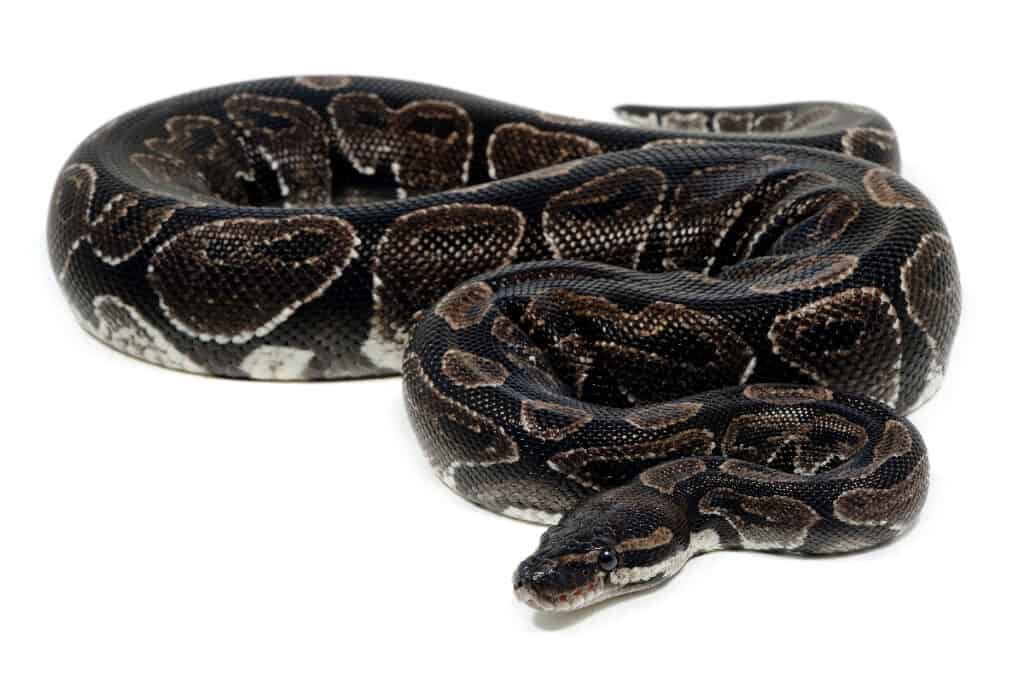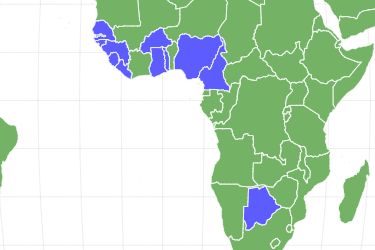Axanthic Ball Python
Python regius
Axanthic ball pythons lack yellow pigment in their skin!
Advertisement
Axanthic Ball Python Scientific Classification
- Kingdom
- Animalia
- Phylum
- Chordata
- Class
- Reptilia
- Order
- Squamata
- Family
- Pythonidae
- Genus
- Python
- Scientific Name
- Python regius
Read our Complete Guide to Classification of Animals.
Axanthic Ball Python Conservation Status
Axanthic Ball Python Facts
- Prey
- Rodents
- Main Prey
- Rats and mice
- Group Behavior
- Solitary
- Fun Fact
- Axanthic ball pythons lack yellow pigment in their skin!
- Other Name(s)
- Royal python
- Temperament
- Docile, curious, hardy
- Litter Size
- 5 to 10 eggs per clutch
- Habitat
- Savanna, grassland
- Diet
- Carnivore
- Lifestyle
- Nocturnal
- Common Name
- Ball python, Royal python
- Location
- Sub-Saharan Africa
View all of the Axanthic Ball Python images!
“The axanthic ball python morph lacks yellow pigment in its skin and was first developed in 1997.”
Axanthic Ball Python Summary
Since the early 1990s, more than 4,000 different ball python morphs have been developed via the process of careful, repeated selective breeding in captivity.
Axanthic ball pythons possess a recessive genetic mutation known as axanthism. Ball pythons with this mutation are unable to produce yellow pigments, or xanthophores, in their skin. As a result, they have no yellow coloration and instead are varying shades of gray, silver, white, brown, and black. They also often have reduced patterning compared to standard, wild ball pythons.
The axanthic morph was first reliably produced in captivity in 1997 by the breeders at VPI, Vida Preciosa International, and most axanthic ball pythons today descended from VPI’s original line.
4 Amazing Axanthic Ball Python Facts
- The axanthic morph is one of the oldest ball python morphs to be reliably produced and sold in captivity, dating back to 1997!
- Because they are a base morph, these snakes can occur naturally in the wild. However, they are extremely rare.
- Many variants of the axanthic morph and combinations with other morphs exist, such as the axanthic pinstripe, axanthic spider, and axanthic pastel morphs.
- It is common for these snakes to be more greyish in color at birth and then gradually become slightly browner in color as they age.
Where to Find Axanthic Ball Pythons
The standard, wild-type ball python is native to Sub-Saharan African countries like Ghana, Senegal, Nigeria, and Cameroon. It primarily lives in grassland and savanna regions, though it can also sometimes be found in more forested habitats.
They can occur naturally in the wild, though they are very rare. The first axanthic ball python was produced in 1997 by VPI, and most of these snakes today descended from VPI’s original line. Because it is well understood and fairly easy to produce in captivity, the axanthic morph is one of the least expensive and more accessible morphs on the market today.
They can now be readily purchased from a wide range of reptile breeders for around $200 to $400 per snake on average. Keep in mind, combination morphs that include the axanthic morph are typically more costly depending on their exact traits.
Scientific Name
The ball python’s scientific name is Python regius, which translates to “royal python.” All ball python morphs share the same scientific name, as they all belong to the same species.
The name “royal python” is a reference to the common belief that Queen Cleopatra and various African tribe leaders often wore ball pythons around their wrists as fashion accessories.
Population and Conservation Status
The IUCN Red List classifies the ball python, Python regius, as near threatened as of 2012. This means although it is not threatened with extinction currently, it could become endangered in the future. It is unknown exactly how many of these pythons exist in captivity and/or in the wild.
How To Identify Axanthic Ball Python: Appearance and Description
Axanthic ball pythons can be differentiated from standard, wild-type ball pythons and other morphs by their distinctly monochromatic coloration. Because they cannot produce yellow pigment in their skin, they are mainly grey, silver, white, black, and brown in color. Their size, shape, overall appearance, and scale patterning are all similar to that of wild-type ball pythons, but without any yellow pigmentation.
On average, they are roughly 4 to 6 feet long upon reaching adulthood. Like most pythons, they are fairly bulky with a slightly elongated, triangular-shaped head. They are timid, docile snakes that get their common name from their habit of defensively curling their bodies into a ball when they are upset or scared.
In short, keep these features in mind when identifying an axanthic ball python:
- Lack of yellow pigmentation, resulting in a mostly grey, white, silver, black, and brown snake
- Can sometimes have reduced patterning when compared to wild-type ball pythons, especially if it shares traits with another morph with reduced patterning
- Brown coloration can become more prominent with age; hatchlings and juveniles typically have less brown coloration overall than adults

Axanthic pythons are unable to produce yellow pigments; they feature some combination of grey, white, silver, black, and brown.
©iStock.com/Florian DENIS
Axanthic Ball Python: How Dangerous Are They?
Like all other pythons, the ball python is not venomous because it kills its prey via constriction. All ball python morphs, including the axanthic morph, belong to the same species, so none of them are venomous.
In addition to their lack of venom, ball pythons are not particularly aggressive toward humans. They have small teeth but lack fangs and have flexible yet weak jaws. Rather than striking, they will typically curl up in a ball or simply flee when provoked or startled.
If you are bitten by a ball python, first carefully place the snake back into its enclosure once you have determined it is not injured. Next, carefully clean the bite wound with warm water and soap. Bandaging the bite wound will prevent infection and speed up the healing process. Most ball python bites are minor and require very little medical intervention.
Axanthic Ball Python Behavior and Humans
Ball pythons are one of the most popular and widespread pet reptiles in the world. This is mainly due to their docile nature, small size, unique appearance, and relatively simple care requirements.
Because they are so easy to care for and breed easily in captivity, thousands of ball python morphs have been developed by a wide range of reptile breeders since the early 1990s. The axanthic morph remains one of the most accessible, inexpensive, and popular morphs. This morph can technically occur naturally in the wild, though this is very rare.
Related Animals:
View all 194 animals that start with AAxanthic Ball Python FAQs (Frequently Asked Questions)
Are axanthic ball pythons venomous?
Like all other pythons, the ball python (and all of its morphs, such as the axanthic) is non-venomous and mainly takes down its prey via constriction. It has small, sharp teeth that curve backward to allow it to grip its prey. However, it lacks fangs and has an overall weak bite.
How do axanthic ball pythons hunt?
Ball pythons are ambush hunters that kill their prey via constriction. They lie in wait, usually cleverly camouflaged, until a prey animal crosses their path and will strike at the right moment.
When a ball python strikes, it will grab onto its prey with its backward-curving teeth and quickly coil its body around the prey and squeeze it as tightly as possible. This slowly suffocates the prey animal. Afterward, the python will swallow the prey animal whole with its incredibly flexible jaws and slowly digest it over several days or even weeks.
All ball pythons, regardless of the morph, hunt their prey in the same way.
Are axanthic ball pythons aggressive?
Ball pythons are not particularly aggressive toward humans. Rather than biting, they tend to curl up in a ball or flee when startled or upset. They will generally only bite a human defensively if they feel they are unable to escape.
Where do axanthic ball pythons live?
Ball pythons are native to Sub-Saharan Africa. Today, they are bred in captivity by reptile breeders worldwide. Thousands of unique color morphs exist, including the axanthic morph. The axanthic morph was first developed in 1997, though it can technically occur naturally in the wild.
What do axanthic ball pythons eat?
Ball pythons primarily eat small mammals like rodents and occasionally small birds. In captivity, reptile owners commonly feed them captive-bred rats and mice.
How much do axanthic ball pythons cost?
On average, axanthic ball pythons cost around $200 to $400. The base axanthic morph is one of the most common and accessible ball python morphs on the market today. Axanthic hybrid morphs like the axanthic spider, axanthic pastel, and axanthic pied morphs are typically more expensive due to being more difficult to produce in captivity.
Are axanthic ball pythons rare?
Axanthic ball pythons are quite common in the exotic pet trade overall. However, they are extremely rare in the wild.
Thank you for reading! Have some feedback for us? Contact the AZ Animals editorial team.
Sources
- Morph Market, Available here: https://www.morphmarket.com/morphpedia/ball-pythons/axanthic-vpi/
- Oakland Zoo, Available here: https://www.oaklandzoo.org/animals/ball-royal-python
- San Diego Zoo, Available here: https://animals.sandiegozoo.org/animals/python
- UCIN Redlist, Available here: https://www.iucnredlist.org/species/177562/15340592
- Reptiles Magazine, Available here: https://reptilesmagazine.com/ball-python-morph-history/

















